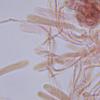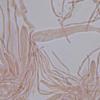
07-12-2025 16:07
Arnold BüschlenHallo, ich habe in einer Moos-Aufsammlung (epiohy

05-12-2025 17:33
 Bruno Coué
Bruno Coué
Bonjour, je serais heureux de recueillir votre avi

07-12-2025 09:24
De la pasada semana en Galicia EspañaEn el suelo

06-12-2025 00:19
 Viktorie Halasu
Viktorie Halasu
Hello, would anyone have this article, please? An

02-12-2025 18:59
This pair of ascos 2.5cm across were on recently b
Ionomidotis
Salvador Tello,
04-02-2018 15:45
En octubre del año pasado recogí un grupo de 5 hongos de 0.5-2 mm de diámetro creciendo en madera de Ononis aragonensis.
Apotecios discoides, de 0.5-2 mm de diámetro, cortamente estipitados, que comparten la misma base, con el himenio negruzco y exterior concolor, que reaccionan en KOH desprendiendo pigmentación ocrácea o rojiza. Excípulo ectal compuesto por células marrones de textura globuloso-angular, con algunos pelos hifoides en el exterior. Excípulo medular compuesto por células alargadas hialinas de textura intrincata, rodeadas de por una capa de gel de color marrón claro. Ascas octospóricas, cilíndrico-claviformes, IKI -, con croziers en la base, de (51,8) 61,6 - 83,9 (85,8) × (7,4) 7,7 - 9,8 (10,2) µ, Me = 70,4 × 8,6 µm . Ascosporas por lo general cilíndricas, ligeramente alantoides, lisas, hialinas, con algunas pequeñas gotas de aceite generalmente en los extremos, de (8,6) 9,4 - 12,1 (13,4) × (2,6) 2,9 - 3,5 (3,9) µm, Q = (2,2) 3 - 4 (4,5) ; N = 68, Me = 10,8 × 3,2 µm ; Qe = 3,4. Paráfisis cilíndricas, de ápice no engrosado, hialinas, septadas, más largas que las ascas, sin VBs en su interior, envueltas por una masa marrón en la parte superior.
Pensaba que podría ser Ionomidotis fulvotingens, pero el excípulo ectal debería de ser de textura prismática y creo que las esporas también son demasiado largas y anchas.
¿Me pueden ayudar? Gracias.
Saludos.
Salvador.
Hans-Otto Baral,
04-02-2018 18:07

Re : Ionomidotis
Hi Salvador
I fulvotingens is a very difficult group of species which requires DNA. In your case it seems that the species can be distinguished more easily. No idea if this has got any name.
In this group I found that the asci have an apical thickening in one species and not thickening in another, both curreently named I. fulvotingens. Of course, the thickening is only obvious in the dead state.
Indeed the spores are much too large. The texture is also angularis in a sample on Ulex (see my Ulex folder), but usuallly it is gelatinised and more prismatic (vertically oriented).
Zotto
I fulvotingens is a very difficult group of species which requires DNA. In your case it seems that the species can be distinguished more easily. No idea if this has got any name.
In this group I found that the asci have an apical thickening in one species and not thickening in another, both curreently named I. fulvotingens. Of course, the thickening is only obvious in the dead state.
Indeed the spores are much too large. The texture is also angularis in a sample on Ulex (see my Ulex folder), but usuallly it is gelatinised and more prismatic (vertically oriented).
Zotto
Salvador Tello,
05-02-2018 08:14
Re : Ionomidotis
Muchas gracias por su respuesta Zotto. Ya había visto su carpeta de Ionomidotis en Ulex.
He estado revisando mis fotos y no he visto engrosamiento en el ápice de las ascas muertas.
Saludos.
Salvador.
He estado revisando mis fotos y no he visto engrosamiento en el ápice de las ascas muertas.
Saludos.
Salvador.
Hans-Otto Baral,
05-02-2018 08:36

Re : Ionomidotis
Can you show me the photos where you see this absence?
I can imagine that Kadri would be interested to investigate this fungus.
I can imagine that Kadri would be interested to investigate this fungus.
Hans-Otto Baral,
05-02-2018 09:54

Re : Ionomidotis
Thanks, good! This seems to be typical that the thickening is absent. But at least in the yellow-ochre species the apical thickening is distinct.

 Ionomidotis-en-Ononis-aragonensis-1--0001.jpg
Ionomidotis-en-Ononis-aragonensis-1--0001.jpg


